Exploring the Velvet Tree Ant: Ecology and Significance
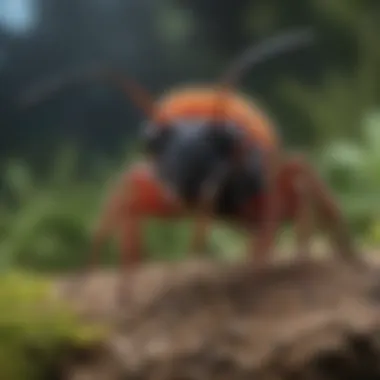
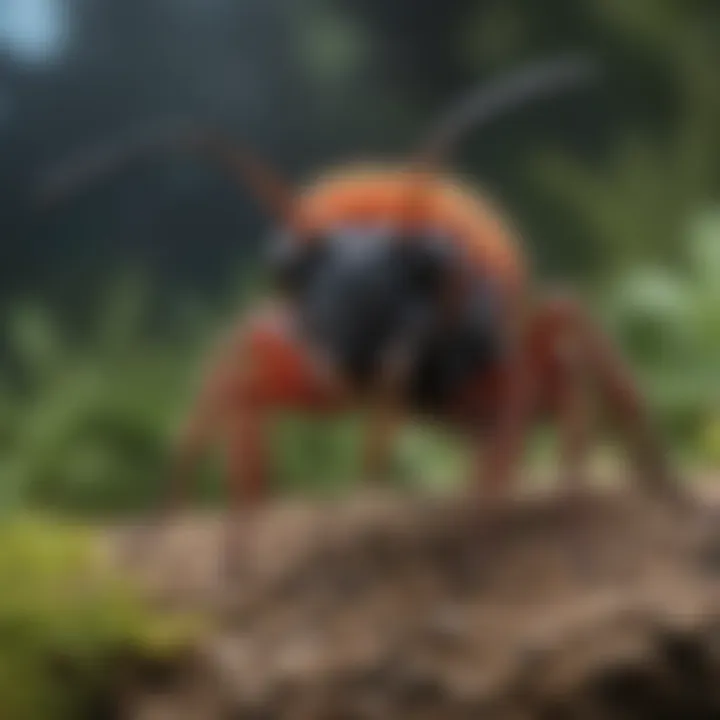
Intro
The velvet tree ant, known scientifically as a member of the Formicinae subfamily, occupies a curious niche in nature. With characteristics that trap both the eye and intellect, these ants are more than mere pests. Their unique adaptations allow them to thrive in diverse ecosystems, contributing significantly to their habitats while also playing pivotal roles in broader ecological dynamics.
In this exploration, we delve into the various aspects that define the velvet tree ant. From understanding its biology to its interaction with the environment, we aim to shed light on why these ants matter in both ecological terms and pest management strategies. We’ll break down the essentials, providing insights that are relevant not just for researchers but also for everyday householders and landscapers who might encounter these creatures.
Understanding the Pest
Identification
Identifying the velvet tree ant involves looking at various physical traits. These ants often have a velvety appearance and can be distinguished by their relatively large size that ranges from three to twelve millimeters. Their bodies typically exhibit a reddish-brown or black coloration, and the absence of prominent spines gives them a smooth outline.
In addition to these colorations, their antennae are conspicuously bent and long, adding to their unique profile. Notably, their behavior also serves as a giveaway; they tend to be highly aggressive when disturbed, which is a significant factor to consider for anyone trying to manage their populations.
Life Cycle
The life cycle of the velvet tree ant unfolds in distinct stages: egg, larva, pupa, and adult. The queen lays hundreds of eggs during the warmer months, with larvae developing rapidly due to the suitable environmental conditions. Once mature, the larvae undergo a pupation stage before emerging as adults.
- Eggs: Laid in clusters, anchored to the nesting surface.
- Larvae: Fed by worker ants, they grow quickly.
- Pupae: Usually formed within a silken cocoon, a step toward adulthood.
- Adults: The mature ants, equipped for reproduction or colony work.
"Understanding the life cycle is crucial to appreciating the velvet tree ant's ecological impact. When one considers how quickly populations can grow in favorable conditions, it becomes evident why monitoring these ants matters."
This life cycle allows the velvet tree ant to reproduce efficiently, ensuring that they can adapt and survive within various environments. Given their role in both soil aeration and pest management, these ants display a dual importance that benefits ecosystems and agricultural practices alike.
Pest Prevention Strategies
Environment Modification
Preventing velvet tree ants from becoming an issue starts with making adjustments in the environment. This entails keeping your surroundings clean and minimizing potential nesting sites. Here are some steps to consider:
- Regularly clear away debris, like dead leaves or wood piles, where ants can thrive.
- Seal cracks and gaps in buildings and outdoor structures to reduce entry points.
- Maintain a dry environment by fixing leaks and ensuring adequate drainage.
These strategies can create a less hospitable environment for the velvet tree ant and deter their nesting tendencies.
Physical Barriers
Beyond environmental modifications, employing physical barriers can provide an additional layer of protection against velvet tree ant invasions. Here are a few measures:
- Use diatomaceous earth around potential entry spots. This powder can dehydrate and kill ants that come into contact with it.
- Install door sweeps and window screens to block entry points effectively.
- Utilize mesh barriers in gardens to protect vulnerable plants from ant activity.
Implementing these barriers can dramatically reduce the likelihood of velvet tree ants establishing significant colonies in your area.
Control Methods
Chemical Control
For those facing more severe ant problems, chemical control methods could be a consideration. Various insecticides specifically target ant species, including the velvet tree ant. When using such chemicals, it is essential to follow safety guidelines and label instructions to minimize harm to non-target species and the environment.
- Baits: Can attract ants and deliver poison to the colony.
- Sprays: Useful for immediate control where large infestations are present.
Biological Control
Biological control strategies involve using natural predators to manage velvet tree ant populations. While these methods require patience and research, they offer a sustainable approach to pest management.
- Introducing specific nematodes or fungi that target ant populations can reduce their numbers over time without chemical impact.
- Encouraging natural predators like birds or other beneficial insects can help keep these pests in check.
These biological measures enhance ecological balance, maintaining healthy populations of both ants and their natural enemies.
With a firm grasp of the velvet tree ant's identification, life cycle, and management strategies, both householders and pest control professionals can make informed choices that sustain ecological balance while addressing pest concerns.
Intro to the Velvet Tree Ant
When we think about the intricate web of life surrounding us, certain elements often go unnoticed yet play vital roles in maintaining the balance of ecosystems. One such remarkable actor in this drama of biology is the velvet tree ant. This fascinating ant, belonging to the Formicinae subfamily, is more than just an insect that wanders in the shadows of the trees. It embodies a range of ecological functions that are crucial for both flora and fauna.
Understanding the velvet tree ant opens a window into its important contributions to various environments. These ants exhibit unique evolutionary traits that allow them to thrive in a variety of habitats, and their behaviors reveal much about the dynamics of interactions with other species.
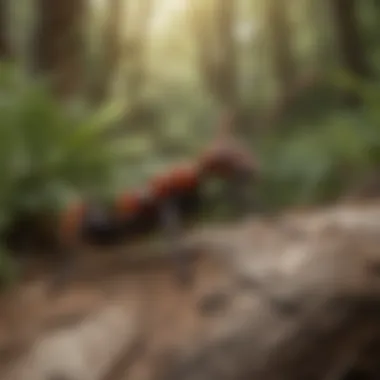

In this section, we explore the foundational aspects of the velvet tree ant, starting with its definition and classification, followed by an examination of its geographic distribution and habitat preferences. Grasping these basic elements sets the stage for appreciating the complexity of its role in the ecosystem.
Definition and Taxonomy
The velvet tree ant is part of the extensive and diverse Formicinae subfamily within the larger order of Hymenoptera, which also includes bees and wasps. It's important to note the hierarchy of its taxonomy:
- Kingdom: Animalia
- Phylum: Arthropoda
- Class: Insecta
- Order: Hymenoptera
- Family: Formicidae
- Subfamily: Formicinae
- Genus: (specific genus can vary)
- Species: (various species such as Zygiella, etc.)
These ants showcase a distinctive morpho-physiological profile and are often recognized by their soft, velvety appearance, hence the name. Their physical traits can vary significantly between species, contributing to their adaptability across regions.
Distribution and Habitat
Velvet tree ants are typically found in tropical and subtropical regions, with a notable presence in rainforests and jungles. The preference for these lush environments is due to a few factors:
- Temperature: They thrive in warm climates, which helps in their metabolic processes.
- Humidity: A damp environment supports the lush vegetation that these ants rely on for food and shelter.
- Biodiversity: Rich ecosystems provide ample resources, from prey to nesting materials, facilitating their survival and interaction with other species.
The velvet tree ant can nest in tree hollows or beneath leaf litter. Such diversified nesting habits offer protection from predators while maintaining proximity to foraging areas. As they build their homes, their communities help to aerate the soil and decompose organic matter, thus contributing positively to their surroundings.
This section has illuminated the velvet tree ant's foundational role through its definition, taxonomy, and habitat distribution. Each element is a piece of a larger puzzle, revealing how intertwined this ant is with its environment and the importance of understanding it in the broader context of ecological study.
Morphological Characteristics
Understanding the morphological characteristics of the velvet tree ant is vital for grasping its role within ecosystems. These features not only reflect the ant's evolutionary journey but also determine how effectively it interacts with its environment, other species, and even with human activities. Such knowledge equips house owners and eco-conscious individuals to appreciate the complexities of nature right in their own backyards.
Physical Features
The velvet tree ant, belonging to the Formicinae subfamily, exhibits a unique blend of size and structure that makes it easily identifiable. Typically, these ants range from 5 to 10 millimeters in length, depending on the specific species. The head is large and roughly rounded, featuring prominent mandibles that showcase their strength.
- Distinct Body Segments: Their bodies are divided into three main segments: the head, thorax, and abdomen. The lack of a petiole, which is a narrow waist found in many ants, gives them a more robust appearance.
- Leg Structure: Legs are relatively long in proportion to their bodies, enabling agile movement through dense foliage, which is essential for their foraging habits.
The physical characteristics of the velvet tree ant allow it to thrive in various habitats, from lush forests to semi-arid regions. Additionally, their robust nature helps them resist some predators, ensuring their survival.
Coloration and Texture
The coloration and texture of velvet tree ants add another layer of complexity to their morphology. Typically, these ants possess a deep black or dark brown hue, with some species displaying reddish undertones. This coloring serves multiple functions in their ecological interactions.
- Matte Finish: The body often has a soft, velvety texture that isn’t just for show. This texture helps in camouflage amongst the flora, allowing them to blend seamlessly into their surroundings, which is crucial for avoiding predators.
- Reflectivity: Interestingly, their coloration can also affect how they interact with sunlight. A darker exterior absorbs more heat, which can be beneficial in cooler climes, aiding thermoregulation during foraging or nesting.
"The velvet tree ant’s morphological characteristics are more than just aesthetic; they’re integral to its survival in diverse ecosystems."
These elements of coloration and texture highlight the complexity of the velvet tree ant, showcasing its adaptability and the evolutionary strategies it employs to thrive in varying climates and environments.
Behavioral Patterns
Understanding the behavioral patterns of the velvet tree ant offers essential insights into its life cycle and interactions within its environment. The way these ants forage, build their nests, and structure their colonies largely dictates their survival and effectiveness in their ecological niche. For house owners and individuals interested in nature, grasping these behaviors can illuminate why these ants thrive in specific areas and how they might inadvertently invade homes.
Foraging Habits
The foraging habits of velvet tree ants are fascinating, not only for their methodical approach but also for their efficiency. These ants do not just wander aimlessly in search of food; they use intricate pheromone trails to communicate and mark successful routes to food sources, essentially creating a network that optimizes their foraging process.
They exhibit a preference for sugary substances, often spotted seeking out honeydew from aphids or enjoying fruits that might be left out. Interestingly, they are also known to forage in larger groups, which enhances their chances of finding and obtaining food while simultaneously supporting their colony.
- Key aspects of foraging habits include:
- Pheromone Communication: Helps ants signal pathways to and from food sources.
- Nutritional Choices: Preference for sugary substances and proteins ensures a balanced diet.
- Collaboration: Collective foraging increases success rates.
"The velvet tree ant’s ability to work together makes them a powerful force in their ecosystem."
This strategic approach not only benefits them but also impacts the ecosystem. As they forage, they inadvertently assist in pollination while controlling pest populations, showcasing their ecological importance beyond mere scavengers.
Nesting Behavior
Nesting behavior in velvet tree ants further illustrates their adaptability and resilience. Unlike some ants that are picky about their nesting sites, the velvet tree ant has shown flexibility in choosing habitats that others might overlook. They often establish nests in tree crevices, under debris, or inside rotting wood, allowing them to exploit niches that offer both protection and access to resources.
Their nests are social hubs where communication thrives, primarily through pheromones and tactile interactions. The construction of their nests tends to reflect their resourcefulness—they use materials available in their environment to create a safe space for their queen, larvae, and workers.
- Noteworthy points about nesting behavior:
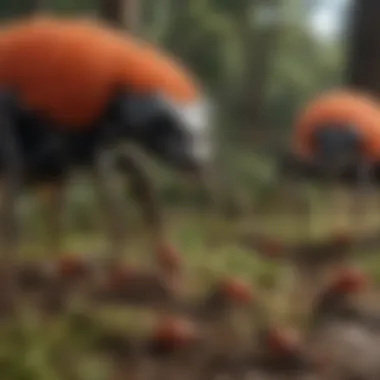
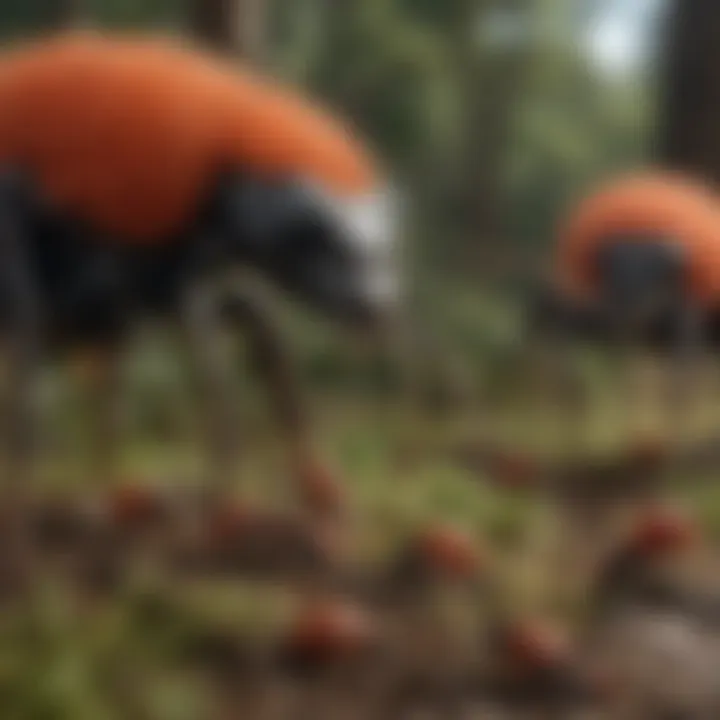
- Adaptability: Ability to nest in various habitats ensures survival.
- Social Dependency: Close communication fosters colony cohesion.
- Utilization of Resources: Building nests with locally sourced materials enhances efficiency.
This unique nesting behavior not only supports the colony's wellbeing but also highlights the species' continuous adaptation to environmental changes, allowing them to thrive in diverse ecosystems.
Colony Structure
The colony structure of velvet tree ants is a complex and intricate system that underscores their social nature. At the core of this structure lies the queen, whose primary role is reproduction. However, the worker ants, which are sterile females, take on the burden of foraging, nest building, and caring for the young, demonstrating a well-organized division of labor.
Colony sizes can vary widely, with some nests housing only a few dozen ants while others may contain thousands. The interactions among these different roles create a balance that is essential for maintaining the colony's health.
- The main features of their colony structure include:
- Queen Role: Focused on reproducing and ensuring colony growth.
- Worker Roles: Diverse tasks among workers, from foraging to nursing.
- Colony Dynamics: The hierarchy and cooperation among members reflect an effective social structure.
Understanding the colony structure paints a clearer picture of their resilience and adaptability, which can also influence local pest management strategies. Homeowners should be aware that the presence of these ants can act as both a nuisance and a beneficial aspect of a balanced ecosystem.
Ecological Role
The velvet tree ant holds a significant position within its natural habitats, contributing in various ways to the ecosystem's overall health and function. Its roles extend beyond simple survival; they influence biodiversity and even agricultural practices. Understanding these dynamics is critical for those engaged in gardening, landscaping, or any form of ecological preservation.
Predator and Prey Relationships
In the grand scheme of nature, everything is circular. The velvet tree ant, as a predator, primarily targets small insects like aphids and other soft-bodied organisms. This predatory behavior helps regulate the population of these pests, preventing outbreaks that can devastate plant life. On the other hand, these ants themselves become prey for larger animals, such as birds and other predatory insects. This relationship illustrates a delicate balance in the chain of life.
Interestingly, velvet tree ants utilize a strategy known as "trophic cascading," where their hunting activities indirectly benefit plants by controlling herbivore populations. It's a classic case of a little creature making a big impact. Without such natural predators, plant health can decline, leading to a less vibrant ecosystem overall.
Contribution to Ecosystem Health
Beyond mere predation, velvet tree ants contribute to ecosystem health in more nuanced ways. By aiding in soil aeration through their tunneling activities, these ants promote the movement of air and water through the soil—crucial for root health of surrounding flora. This subterranean activity helps to maintain soil structure and fertility, which is vital for sustaining plant communities.
Furthermore, these ants often engage in seed dispersal. They collect seeds from various plants, transporting them to their nests, where they deposit them, enriching the soil with nutrients. This process not only aids in the propagation of certain species but also enhances plant diversity, ultimately contributing to a more resilient ecosystem.
In essence, velvet tree ants act like miniature gardeners, nurturing their environment in ways many species overlook.
Mutualistic Symbiosis with Other Species
The velvet tree ant's ecological role also extends into the realm of symbiotic relationships. One of the most fascinating aspects of their behavior is their mutualism with aphids. These ants protect aphid colonies from their natural enemies in exchange for honeydew, a sugary secretion produced by aphids. This relationship showcases an interdependence that benefits both parties. The ants enjoy a consistent food source, while the aphids benefit from protection, allowing them to thrive in otherwise hostile environments.
Moreover, interactions with fungi are noteworthy. Some species of velvet tree ants cultivate fungi within their nests, providing the fungi with plant material while deriving sustenance from it in return. This cooperative dynamic boosts nutrient cycling within the ecosystem, underscoring the richness of ant behaviors and their far-reaching significance.
Human Interaction
Understanding the human interaction with the velvet tree ant leads to better insights about our shared environments. As these ants are not just mere inhabitants of their ecosystems, but also play a significant role in agriculture and pest control, the dynamics of their interaction with humans deserve focused scrutiny. Households and farmers alike may particularly feel the brunt of any changes in their populations, making it essential to grasp their ecological significance in relation to human activities.
Impacts on Agriculture
The velvet tree ant's presence in agricultural settings can be a double-edged sword. On one hand, these ants can transform local flora by enhancing the availability of nutrients. Their nesting habits often aerate the soil, fostering better conditions for plants, which in turn can boost crop yields. However, certain species of these ants might also become problematic. For instance, they can tend aphids and other pests, promoting their populations which can devastate crops. Therefore, a keen eye is necessary to identify whether these ants are aiding or hindering agricultural productivity.
- Velvet tree ants can improve soil quality.
- They may indirectly promote pest populations.
- Monitoring their presence is crucial for farmers.
"The velvet tree ants are like a coin tossed in the air; you either catch it with heads up or tails up, depending on their role in agriculture."
Pest Control Perspectives
From a pest control standpoint, velvet tree ants show potential, but they also raise concerns. Their unique foraging behavior can disrupt certain pest life cycles, leading to decreased numbers of harmful insects. This could position them as allies in organic farming or in suburban gardens. However, if their populations become overabundant, they might attract unwanted pests, further complicating pest management strategies.
It's worth noting that control measures should not indiscriminately target velvet tree ants without careful consideration of their ecological benefits. By understanding their role in local ecosystems, pest control professionals can make more informed decisions that respect the balance of nature.
- Potential for biological pest management.
- Can attract or repel other pest populations.
- Need for targeted strategies in pest control practices.
Recognizing these interactions between velvet tree ants and human activities can help develop sustainable practices that allow us to coexist with them, ensuring both agricultural productivity and ecological harmony.
Conservation Status
Understanding the conservation status of the velvet tree ant is crucial, not only for the species itself but also for the broader ecosystems they inhabit. The challenges faced by this insect underscore the interconnectedness of various ecological elements. As we explore the threats and conservation efforts surrounding the velvet tree ant, we can appreciate the intricate balance of nature and the importance of protecting even its smallest residents.
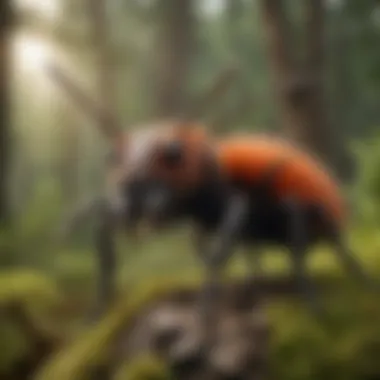
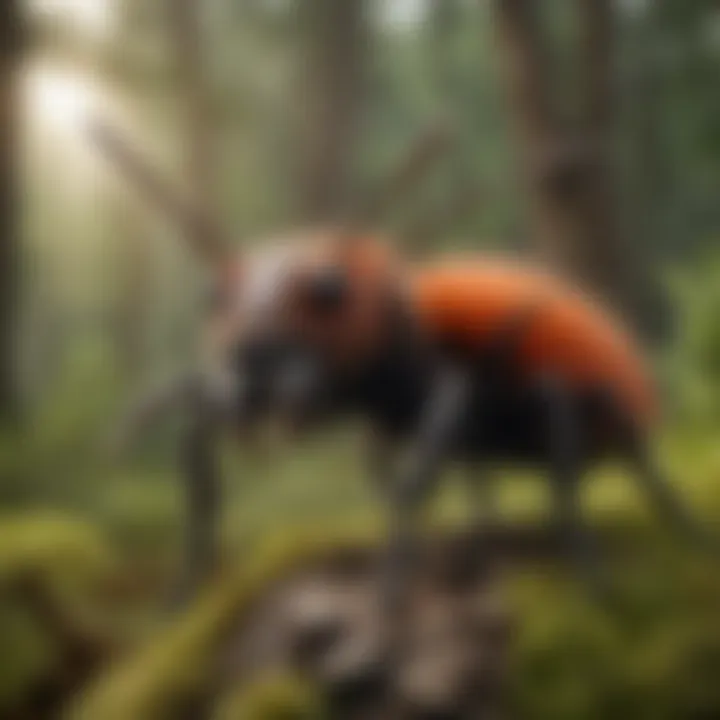
Threats to Population
The velvet tree ant is not without its adversities in its search for survival. Current threats to their populations are quite varied, reflecting changes in both their natural habitats and human activities. Here are some issues that have been commonly observed:
- Habitat Loss: Urban development and deforestation pose significant threats to the velvet tree ant. As forests are cleared for agricultural or industrial use, the ants lose their nesting sites and food resources, putting their populations at risk.
- Climate Change: Fluctuations in temperature and moisture can deeply impact the tree’s ant life cycle, including their foraging behaviors and reproductive success. Changes in climate may also alter the types of plants they rely on for sustenance.
- Pesticide Use: The indirect consequences of agricultural pest control, especially pesticide applications, can weaken or even wipe out local ant populations. Some substances are not selective and can harm beneficial insect species like the velvet tree ant.
Despite these challenges, it is important to remain hopeful; many conservation efforts are underway to mitigate these threats.
Conservation Efforts
Conservation measures to protect the velvet tree ant and its habitats are essential for ensuring the species' survival. Initiatives can range from local community efforts to broader legislative actions. Here are some notable conservation strategies:
- Protected Areas: Establishing nature reserves where velvet tree ants can thrive without human interference is one effective way to protect their population. These designated areas help maintain their natural habitats, allowing them to flourish.
- Community Awareness Programs: Educating residents about the ecological importance of the velvet tree ant has proven beneficial. Such initiatives encourage locals to adopt methods that minimize pesticide use and promote biodiversity.
- Research Initiatives: Ongoing research creates a better understanding of velvet tree ant populations and their ecological needs. Supporting studies can help identify trends and inform conservation strategies effectively.
Protecting the velvet tree ant isn't just about saving one species; it's about maintaining the entire ecosystem's balance.
Research and Studies
The study of the velvet tree ant is not just a pursuit of academic curiosity; it plays a vital role in shaping our understanding of ecosystems. The intricate relationships these ants foster within their habitats offer insights that echo far beyond the realm of entomology. By delving into this area, we can gain knowledge on species interactions, ecosystem health, and, importantly, pest management strategies. This makes research on velvet tree ants quite a hot topic for not only scientists but also homeowners and agriculture professionals who seek effective solutions for pest control.
Recent Discoveries
Recent studies have shed light on the velvet tree ant's remarkable adaptability. Researchers have discovered that these ants utilize a wide range of food sources, including honeydew from aphids and nectar from various plants. This dietary versatility means they are not merely scavengers, but integral to the nutrient cycling within their ecosystems. This adaptability also leads scientists to explore their role in facilitating plant health, as these ants often protect beneficial herbivores from predatory threats.
Moreover, recent field studies have pointed to the velvet tree ant's impressive defensive strategies. For instance, colonies have been observed employing a unique scent-marking method to communicate danger, effectively coordinating group responses against potential threats. Such findings underscore the ant's advanced social behaviors and their implications on species' survival and inter-species interactions.
"The velvet tree ant serves as a model organism, revealing the intricate tapestry of ecological relationships and adaptations. Their role transcends mere pest status; they are vital players in ecosystem dynamics."
Gaps in Knowledge
Despite significant advancements, gaps exist in our understanding of the velvet tree ant's life cycle and reproductive habits. While some studies focus heavily on foraging and nesting behaviors, little is known about how environmental changes affect their reproductive success. Given how climate change disrupts natural habitats, figuring out how these ants adapt or suffer is imperative.
Furthermore, the long-term effects of their interactions with other species also need more thorough investigation. We recognize the velvet tree ant as both predator and prey, but the nuances of these relationships still require exploration. What happens if their primary prey species decline? Would this affect their foraging behavior, or even their colony structure? Insights into these areas would not only enhance our understanding of the velvet tree ant but could also provide broader implications for ecosystem health.
Future Prospects
The ongoing study of the velvet tree ant opens a window into its significant role within its ecosystem. Both researchers and nature enthusiasts alike realize that understanding this ant's behavior and ecological contributions is not merely academic; it has tangible implications for pest management and conservation strategies. Exploring how we can leverage the existing knowledge of this fascinating insect can shape more effective approaches towards ecosystem management.
Role in Ecosystem Management
The velvet tree ant plays a critical role in maintaining the health of its ecosystem. It participates in seed dispersal, aiding in the propagation of various plant species, which promotes biodiversity. By assisting in the growth of plants, these ants contribute to the overall stability of their environment.
- Nutrient Cycling: Through their foraging, velvet tree ants help in breaking down organic matter, which enriches the soil and accelerates nutrient cycling within the ecosystem.
- Food Source: Their presence provides a consistent food source for various predators including birds and mammals, helping maintain the food web.
- Habitat Formation: By nesting in trees and sometimes creating cavities, velvet tree ants can inadvertently assist other species in finding shelter.
Understanding these roles can guide land managers in preserving habitats where these ants thrive, crucial for the overall health of the environment.
Potential in Biocontrol Applications
The velvet tree ant's behavioral patterns make it a noteworthy candidate for biocontrol applications. Given the increasing resistance of pests to conventional pesticides, researchers are now considering this ant as a natural alternative for pest management. Due to their predatory characteristics, these ants can help manage pest populations that threaten crops.
- Natural Pest Control: Velvet tree ants can actively hunt and control pests such as aphids and caterpillars, reducing the need for chemical interventions.
- Low Environmental Impact: Utilizing these ants in agricultural settings could contribute to more sustainable farming practices. This approach limits the chemical runoff that can harm surrounding ecosystems and promotes healthier agricultural methods.
- Harmonious Coexistence: When properly integrated into farming operations, velvet tree ants can coexist with crops without causing harm. Educating farmers about beneficial insects can create a collaborative environment that supports pest control and agricultural productivity.
"The continued exploration of the velvet tree ant's ecological and behavioral traits presents opportunities to harmonize agriculture with natural ecosystems."
As studies progress, a deeper understanding of the velvet tree ant can lead to innovative solutions that transcend traditional pest management, highlighting the intricate connections of species within ecosystems.
Finale
In wrapping up our exploration of the velvet tree ant, it becomes clear that this tiny creature plays a giant role within its ecosystem. Understanding the velvet tree ant isn’t just an academic exercise; it carries real-world implications for pest management, ecosystem health, and biodiversity. With their unique adaptations and actions, these ants not only contribute to the balance of local ecosystems but also serve as indicators of environmental changes that could affect agriculture and human health.
Summary of Key Insights
- Diverse Ecosystem Contributions: The velvet tree ant contributes significantly to soil aeration and nutrient cycling, which indirectly supports the growth of various plant species. This means they don't act alone; their presence benefits not just their own colonies but the wider environment too.
- Pest Management Role: As natural predators, these ants can help regulate the populations of certain agricultural pests. This is critical for farmers looking for eco-friendly pest control methods.
- Threats and Conservation: Although resilient, velvet tree ants face threats from habitat loss and climate change. Their conservation is not just a matter of keeping them around; it’s about safeguarding the multitude of benefits they provide to ecosystems.
"Every ant plays its part in the larger narrative of nature, and the velvet tree ant is no exception. It’s a symphony of interactions that underscores the delicate balance of life."
Call for Ongoing Research
The path forward should involve a commitment to further studying the velvet tree ant and its interactions with various environmental factors. Here are some areas needing attention:
- Behavioral Studies: Understanding the day-to-day activities and communication patterns of velvet tree ants can reveal much about their social structure and adaptability.
- Environmental Impact: Research should focus on how these ants affect soil quality and plant health in different ecosystems, particularly under changing climates.
- To understand their role in pest control better, scientists need to quantify their effectiveness against specific pests within agricultural settings.
Continued investigation into these ants can lead to valuable insights not just into their lives, but into how we might harness their natural behaviors for broader ecological gains. In short, protecting velvet tree ants and appreciating their role could offer significant benefits for both the environment and human activities.





